Search for the perfect rock: Designer creates Japanese garden in Louisville on former dump
LOUISVILLE, Ky. — International Japanese garden designer Shiro Nakane was 35 minutes into a search that would take him back about 300 million years.
He was walking the broad moonscape of a huge Southern Indiana quarry near Sellersburg seeking just the right stones for careful placement in the new Japanese garden to be constructed within Louisville’s Waterfront Botanical Gardens.
Nakane has been on this journey before. It was in many ways a family trip.
He is the son of Kinsaku Nakane, the 1966 founder of Nakane & Associates, an international firm known for creating traditional Japanese gardens and restoring historic temples in Kyoto as well as creating new gardens around the world, including Australia, China, Singapore, Lithuania and the United States.
He has lectured on Japanese gardens in Israel, Germany, Japan and, in the United States, at forums in Portland, Philadelphia and New York. He helped create Japanese gardens at the Jimmy Carter Presidential Center Garden in Atlanta, the National Gallery of Art in Washington and the Museum of Fine Arts in Boston, where he was first flown over New England in a plane to get a larger sense of the landscape.
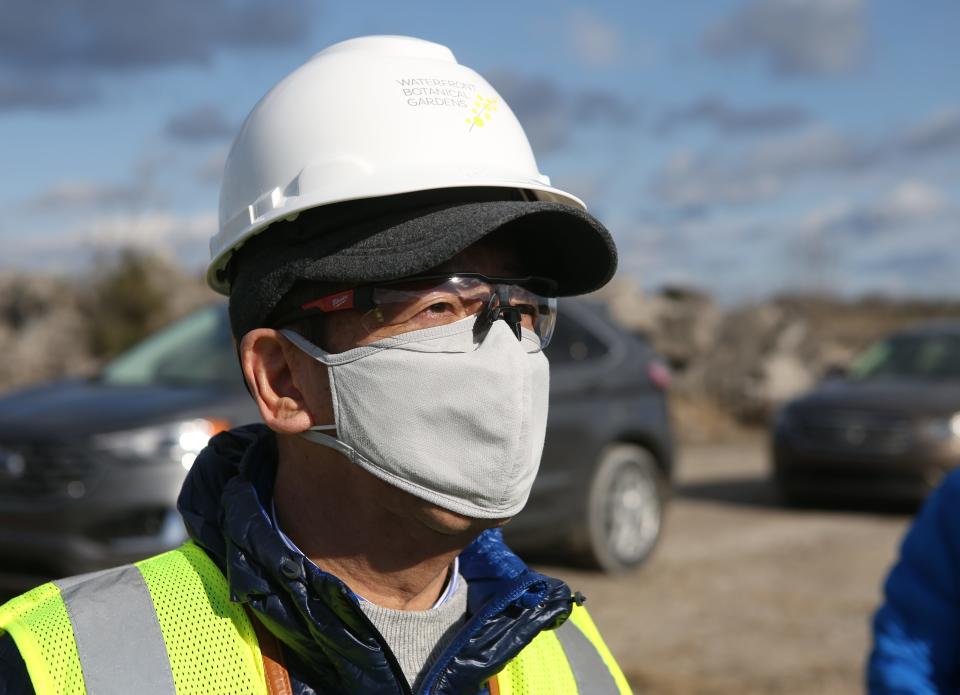
Now, here he was, accompanied by a group from the Waterfront Botanical Gardens and his son, third-generation landscape designer, Yukihiro Nakane, slogging through 2 inches of fresh mud and climbing 20-foot piles of blasted, jagged limestone rock in Southern Indiana to bring a world-class Japanese garden to Louisville.
That valued limestone is the product of what is now Southern Indiana being buried under a warm sea for hundreds of millions of years, the brittle shells of its countless marine invertebrates hardening to limestone up to 90 feet thick over the eons.
Time remains a constant factor in Shiro Nakane’s business — in both rock and plants. He designs his Japanese gardens to last for centuries, albeit also changing constantly as plants come and go.
More from Bob Hill: What it was like to play SEC, Southwest hoops in the '60s
'The rock asked me to restore it there'
He will suggest traditional plants just as carefully as he hand-picks the rocks, a somewhat mystical-sounding art that became his life when a small child at his father’s side.
He remembers that moment. He was standing by his father, watching him as he carefully selected and positioned large, jagged stones in a garden, sometimes moving or turning them only a few inches to bring a certain angle into play.
“Father, ‘Shiro asked him one day, "why did you arrange that rock over there?"
“You didn’t hear?” his father answered. “The rock asked me to restore it there.”
The dutiful son now applies those 1,000-year-old traditional techniques and aesthetics to all his work, combining his strong sense of the past with some realistic perspective — if not equipment.
“Rock arrangement is a bit like choreography,” explained Nakane, 71, who will now use a giant crane to move them. “It can take an hour to twist and turn it until it's placed right.”
Turning a dump into tranquil beauty
Traditional Japanese gardens are designed to become a constant source of solitude and reflection, no matter the size of a garden, nor the climate in which it was built.
The goal is not to make a “new nature” but to copy an existing desirable nature, sometimes replicating in scale landmarks such as Niagara Falls or Mount Fuji but using local materials such as Indiana limestone.
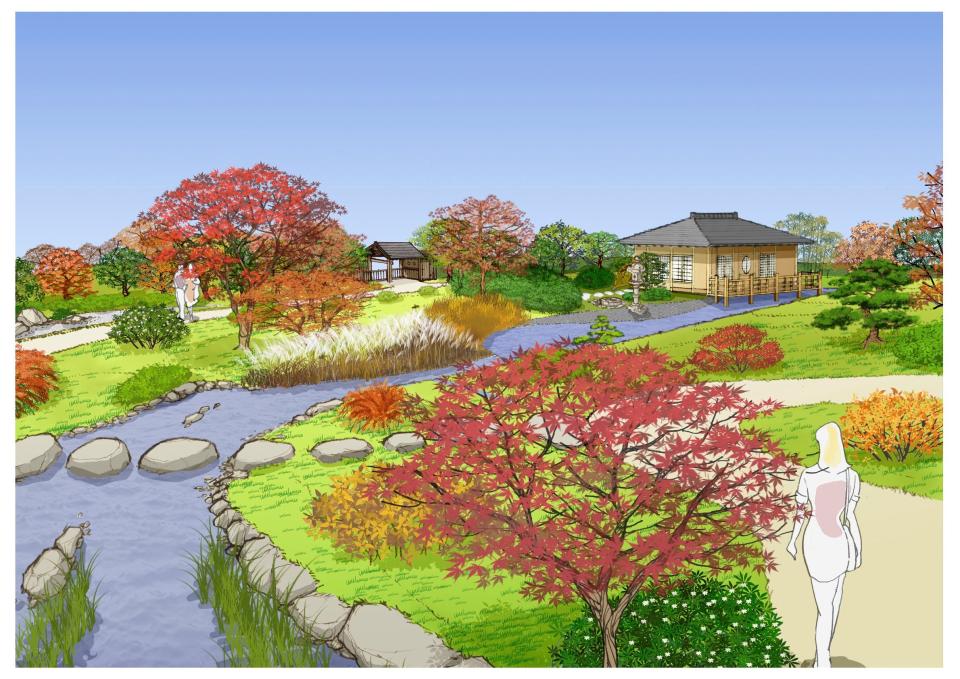
The eventual goal is to create a garden that transcends all racial, religious and cultural differences.
It’s a task made all the more challenging in Louisville where the 2-acre Japanese garden will become part of the already blooming 23-acre Waterfront Botanical Gardens which was built at Frankfort Avenue and River Road on what was once called the Ohio Street dump.
From the 1940s into the 1960s, the dump accepted all garbage from Louisville and many local communities. It took bulldozed debris from the 1937 flood, became the home of wild pigs and even low-burned for months at a time.
'Living art museum': Take a virtual tour of Louisville's Waterfront Botanical Garden plants
In 1973 the EPA closed it and capped it with dirt that is uneven in places.
There it sat alongside Beargrass Creek poking up weeds, aggressive grasses and junk trees until 2009 when the Waterfront Botanical Gardens, wanting to establish an urban garden featuring educational classes, unique gardens and unusual plants and trees, acquired it from Metro Louisville.
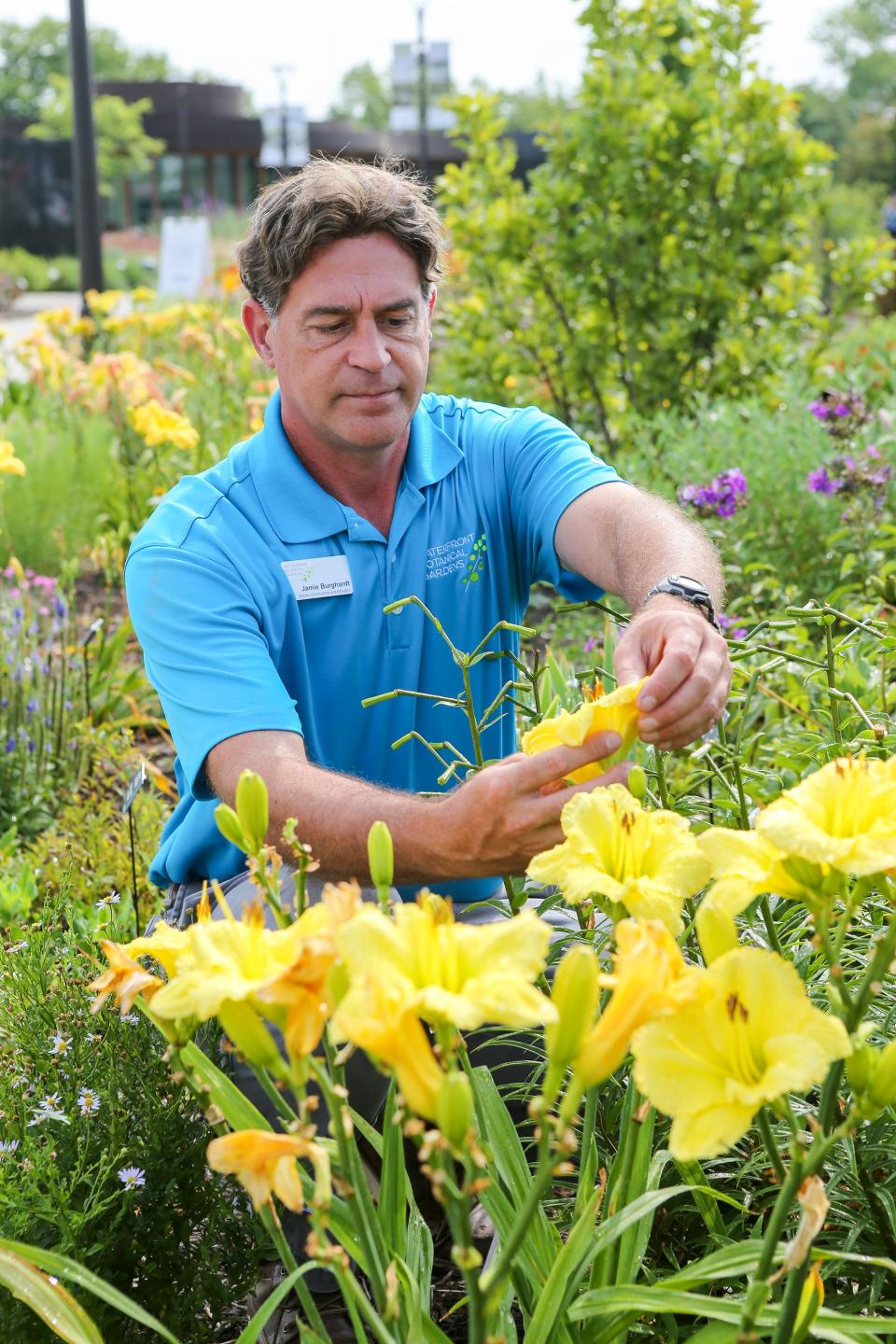
It has since raised $24 million in mostly private and corporate donations; planted thousands of trees, shrubs and flowers; and added two aesthetically interesting buildings for meetings and rentals.
It has plans for a children’s garden, a tree allee, an overlook over Beargrass Creek, a secret garden, a sensory garden and a glass conservatory.
It was partly the challenge of building a world-class Japanese garden on a former dump that led Shiro Nakane, a man who also has a gentle sense of humor and a needed practical side, to come to Louisville in the first place.
He came through the recommendation of Southern Indiana project manager and architect Nick Nakamura, who, when asked in 2018 if he could help build a Japanese garden in Louisville, said he would do so only if the project would include “the best Japanese garden designer in the world, Shiro Nakane.”
Nakane visited Louisville, learned the history of the landfill and his immediate response was basically, “Yes, I will design your garden. Humans created the landfill; humans can beautify it.”
Kasey Maier, president of the Waterfront Botanical Gardens, responded in kind: “We are very lucky to have a Japanese garden designer the caliber of Shiro Nakane.”
How the project is funded
Nakane began with a plan that would include the traditional elements of a Japanese garden: ornate gates, a waterfall, a mountain stream, stepping stones, a pebble beach, a summer house, a heart-shaped pond, islands, a bamboo grove, relevant trees and shrubs, a tea house with a garden, a dry landscape garden, grasslands, a cherry tree promenade and several bridges including the traditional arched red-orange one.
Money for the Japanese garden began through a $500,000 Graeser Family matching fund. Sponsorships have already been found for several of those traditional elements with more funding information available at waterfrontgardens.org.
Staying with tradition, the Louisville Japanese garden will also include the Graeser Family Bonsai Garden, a project already well underway with a $1 million gift from the Graeser family, a $250,000 gift from bonsai enthusiasts Joe and Debbie Graviss, and other donors.
It will include a bonsai cultivation house, seasonal display areas offering many well-tended bonsai plants and a bonsai pathway. All of that will eventually be bordered and lined with interesting trees, shrubs and plants.
The initial plans are now being discussed and modified by the Nakanes and waterfront garden planners. The entire Japanese garden project is scheduled to be open by late 2023 or spring of 2024.
More from Bob Hill: I'm one of the 11 million vaccinated against COVID-19. What it's like to get the vaccine
Descending into the massive quarry pit
It was with these deadlines in mind that Shiro Nakane, his son, and the group from the Waterfront Botanical Garden recently walked a Southern Indiana quarry moonscape seeking limestone rocks to place in the gardens.
It was a cool, bright, crisp morning. We were given white hard hats, clear protective glasses, bright yellow vests and detailed safety instructions by very polite but security-conscious quarry employees.
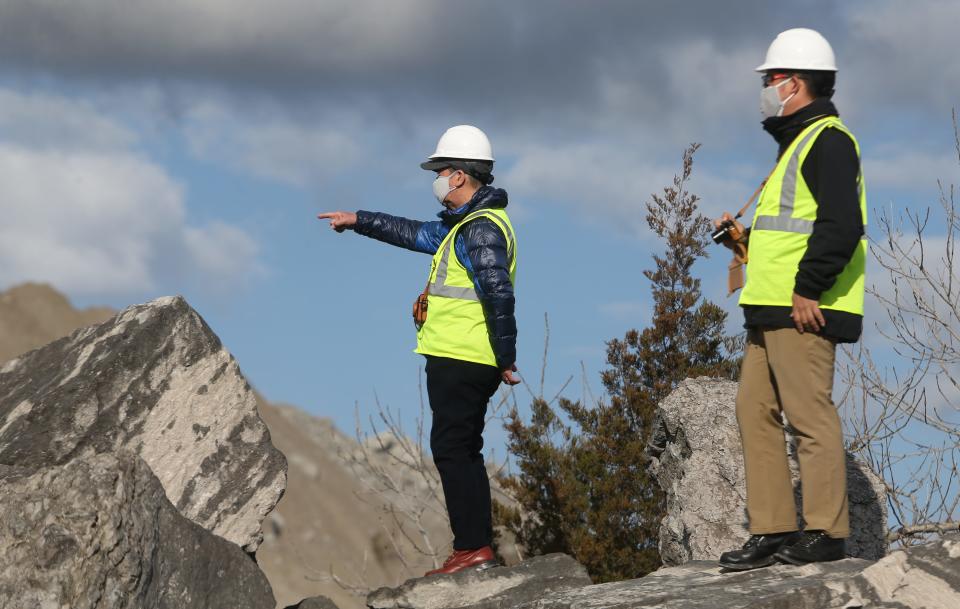
The surroundings were of another world. The rattling, grinding, crunching sounds of hard rock being processed were everywhere. On the way down into the quarry pit we passed monster yellow dump trucks covered in dust, their huge, ridged black tires looming above us as they roared past a safe distance away — Jurassic World on wheels.
The quarry walls rose above us in the distance, their colors distinct, evenly layered by the tens of millions of years of dead crustacean creation. The piles of jagged stones before us had been blasted from those walls, bulldozed into this area and pushed up into a pointed row of mini-Alps.
The Nakanes, father and son, soon disappeared up into pile, then emerged near the top, carefully examining the stones, taking pictures, their bodies silhouetted against a blue, partly cloudy sky.
Yukihiro Nakane was wearing jeans and tennis shoes. He, like his grandfather and father, was drawn into the family business at childhood. He attended the same schools as his grandfather, then earned a degree from the University of Oregon in landscape architecture.
“Since I was 15 years old,” he said, “I wanted to become a person who made landscape drawings and taught across the world.”
His father, ever elegant, wore dark blue slacks and polished, tan oxford shoes on his rocky climb. He later joked about wearing the same pair of Red Wing shoes for 20 years, but with new soles as required.
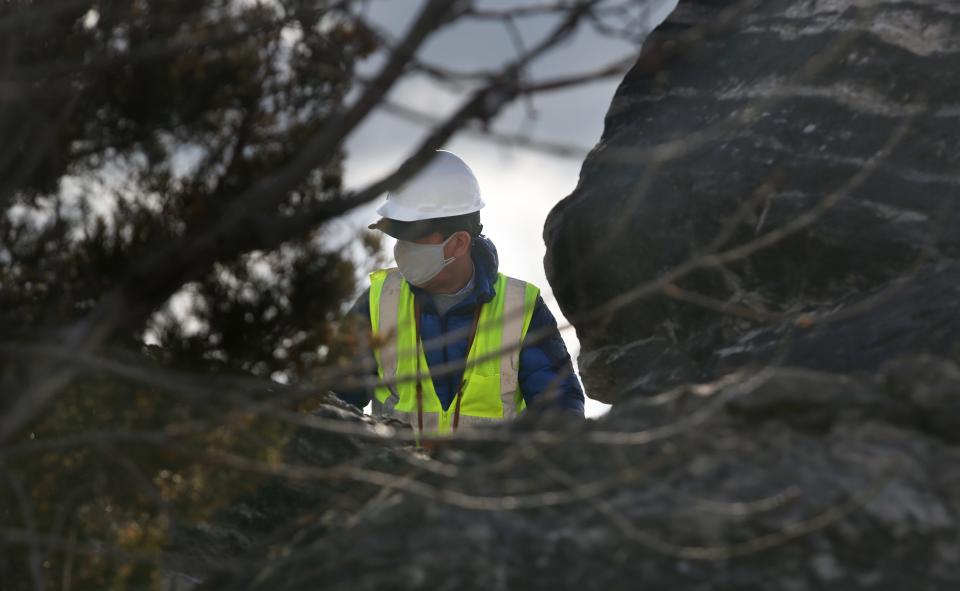
The Nakane search, in many ways, was no different than a landscape painter seeking the right color, a mason just the right bricks for his patio wall or a writer seeking the right word.
In every case you know it when you see it. And many gardeners often talk to their trees and plants.
The Nakanes were joined in their limestone climb by Clinton Deckard, president of Construction Solutions and construction manager of the Waterfront Botanical Gardens.
A well-practiced problem solver, he is now, along with Jamie Burghardt, the waterfront gardens’ director of horticulture and education, a veteran of dealing with the constant problems that come with a former landfill’s soil, drainage and environmental issues, not to forget old, buried objects that work themselves to the surface.
Deep pilings down to bedrock are required to support existing garden buildings and will be needed to support the heavier structures in the Japanese garden.
Talking to the stone
Back on level ground, Deckard and Shiro Nakane discussed which rocks could be moved to the Waterfront Botanical Gardens site for final evaluation and placement, their conversation punctuated with gestures and arm movements.
“I found many interesting, weathered limestones,” Nakane said, “so together we can make a good garden here.”
The initial plan was that a particular long row of angular rocks, some 8 feet long and weighing many tons, could be trucked to Louisville, then analyzed again for final placement.
Nakane explained the process:
“When I meet a stone in storage beside the construction site I start talking with the stone: ‘Oh, hello, guy, you look nice.’ And if it says it’s best for the waterfall, then I chose that one for that place.”
The rock search was also monitored by Zan Stewart, a landscape architect and designer with Perkins & Will of Atlanta, the firm that did much of the design work for the botanical gardens.
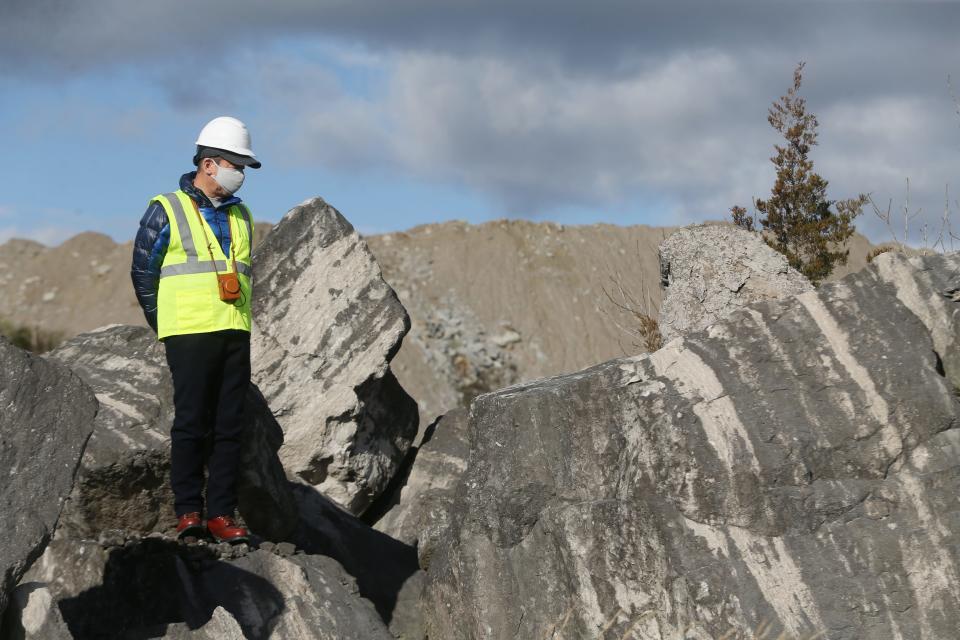
Stewart, who grew up in Louisville, also took part in the quarry rock climb. He sees the big picture results that can come with a world-class Japanese garden in Louisville.
“The importance,” he said, “is its ability to extend a unique experience and educational value to the local community while drawing in regional and global visitors.”
After about an hour in this quarry, Shiro Nakane and Deckard led the group to another Southern Indiana quarry to continue the search.
“Maybe,” said Nakane, smiling, “we will find diamonds.”
Retired Courier-Journal columnist Bob Hill is on the board of the Waterfront Botanical Gardens.
This article originally appeared on Louisville Courier Journal: Famed designer hunts for perfect rocks for Louisville Japanese garden

